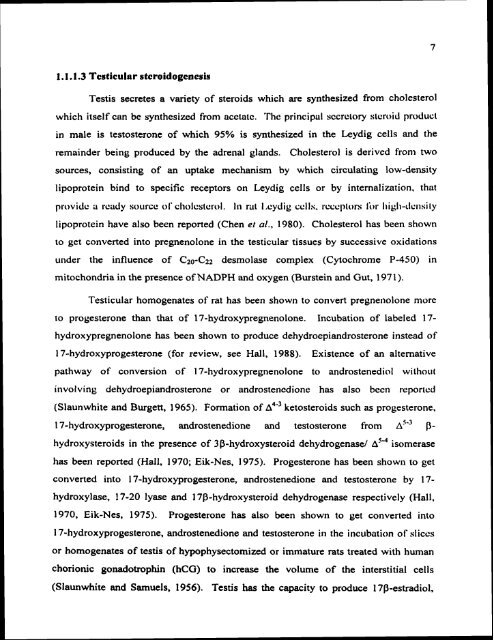ON TESTIS AND EPlDlDYMlS OF RATS - Pondicherry University ...
ON TESTIS AND EPlDlDYMlS OF RATS - Pondicherry University ...
ON TESTIS AND EPlDlDYMlS OF RATS - Pondicherry University ...
Create successful ePaper yourself
Turn your PDF publications into a flip-book with our unique Google optimized e-Paper software.
1.1.1.3 Tcsticular steroidogcnesiv<br />
Testis secretes a variety of steroids which are synthesized from cholesterol<br />
which itself can be synthesized from acetatc. Thc principal sccrctory stcn)id product<br />
in male is testosterone of which 95% is synthesized in the Leydig cells and the<br />
remainder being produced by the adrenal glands. Cholesterol is derived from two<br />
sources, consisting of an uptake mechanism by which circulating low-density<br />
lipoprotein bind to specific receptors on Leydig cells or by internalization. that<br />
provide n ready source ol'cholcstclol. It1 rat I.cydig cells. receptors lir I~igli-ilc~lsily<br />
lipoprotein have also been reported (Chen el al., 1980). Cholesterol has been shown<br />
to get converted into pregnenolone in the testicular tissues by successive oxidations<br />
under the influence of C20-C22 desmolase complex (Cytochrome P-450) in<br />
mitochondria in the presence ofNADPH and oxygen (Burstein and Gut, 1971).<br />
Tcsticular homogenates of rat has been shown to convert pregnenolone more<br />
to progesterone than that of 17-hydroxypregnenolone. Incubation of labeled 17-<br />
hydroxypregnenolone has been shown to produce dehydroepiandrosterone instead of<br />
17-hydroxyprogesterone (for review, see Hall, 1988). Existence of an alternative<br />
pathway of conversion of 17-hydroxypregnenolone to androstenediol<br />
withor~t<br />
involving dehydroepiandrosterone or androstenedione has also been reported<br />
(Slaunwhite and Burgen, 1965). Formation of A~') ketosteroids such as progesterone.<br />
17-hydroxyprogesterone, androstenedione and testosterone from A'" P-<br />
hydroxysteroids in the presence of 3P-hydroxysteroid dehydrogenasel A~~ isomerase<br />
has been reported (Hall, 1970; Eik-Nes, 1975). Progesterone has been shown to get<br />
convened into 17-hydroxyprogesterone, androstenedione and testosterone by 17-<br />
hydroxylase, 17-20 lyase and 17P-hydroxysteroid dehydrogenase respectively (Hall.<br />
1970, Eik-Nes, 1975). Progesterone has also been shown to get converted into<br />
17-hydroxyprogesterone, androstenedione and testosterone in the incubation of slices<br />
or homogenates of testis of hypophysectomized or immature rats treated with human<br />
chorionic gonadotrophin (hCG) to increase the volume of the interstitial cells<br />
(Slaunwhite and Samuels, 1956). Testis has the capacity to produce 17p-estradiol,

















